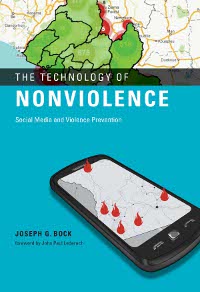 Tunisian and Egyptian protesters famously made use of social media to rally supporters and disseminate information as the “Arab Spring” began to unfold in 2010. Less well known are ongoing local efforts to use social media and other forms of technology to prevent deadly outbreaks of violence. The Technology of Nonviolence describes and documents technology-enhanced efforts to stop violence before it happens in Africa, Asia, and the United States. Kristen Perrin finds that although the book leaves some unanswered questions, Bock does well to highlight phenomena that are recent, in flux, and difficult to quantify.
Tunisian and Egyptian protesters famously made use of social media to rally supporters and disseminate information as the “Arab Spring” began to unfold in 2010. Less well known are ongoing local efforts to use social media and other forms of technology to prevent deadly outbreaks of violence. The Technology of Nonviolence describes and documents technology-enhanced efforts to stop violence before it happens in Africa, Asia, and the United States. Kristen Perrin finds that although the book leaves some unanswered questions, Bock does well to highlight phenomena that are recent, in flux, and difficult to quantify.
 The Technology of Nonviolence: Social Media and Violence Prevention. Joseph G Bock. MIT Press. July 2012.
The Technology of Nonviolence: Social Media and Violence Prevention. Joseph G Bock. MIT Press. July 2012.
Current discussions surrounding the uses of social media are magnifying the implications of near-instantaneous human interaction, with varying degrees of consequence. It seems only fitting that these discussions are often layered – we use social media to discuss the issues and potential of social media. Therein lies a fascinating marker for the time in which we find ourselves. Where we recently marvelled at the speed at which information could reach us, we are now examining a more sophisticated interconnectedness, with a more sophisticated set of problems. What impact, for example, does the timing and spread of information have on communities teetering on the brink of violence?
Joseph G. Bock sets out to answer this question, drawing on his extensive experience in humanitarian aid, adding a digital dimension to some of the issues he has tackled in previous publications (see Sharpening Conflict Management: Religious Leadership and the Double-Edged Sword).
I was initially interested but sceptical on how this topic would be undertaken, but Bock sets about his analysis in a very organised and functional way, and uses his first two chapters to give a straightforward investigation into the theory and application of violence prevention and early warning systems. He makes it immediately clear that efforts to understand the successes and failures of the technology of violence prevention are very new, and that these processes are constantly evolving. He also keeps the heart of the matter close at hand throughout the book: in analysing the technological elements of tracking and preventing violence, we are really analysing people, leadership, politics and communication. Digital innovations are merely symptoms of larger processes, and Bock emphasises that it is ultimately these processes he is seeking to understand.
He uses several case studies to examine the ways in which technology has brought change to early-warning systems as a tool to prevent violence. Interestingly, he begins with a case study in which technology does not play a major role. He describes his research in the slums of Ahmedabad, where he looks at the role of communication in counteracting tensions between the Muslim and Hindu inhabitants there. He describes how a Catholic humanitarian group called St. Xavier’s Social Services Society have been undertaking programmes to promote peaceful coexistence between these groups, to varying levels of success. They have used a variety of methods to spread their message, from staff speaking to people directly, to plays and songs, art and essay contests. Bock highlights the problem with tensions in this area – ethno religious boundaries are often capitalized upon and manipulated by politicians and real-estate entrepreneurs for their own benefit. A large part of the work done to counter violence in these slums has to do with breaking down myths and encouraging people to think before acting violently.
This contrasts well with his other chapters, such as the chapter on crowdsourcing during post-election violence in Kenya. Here, a non-profit technology company called Ushahidi created a platform for spreading event-specific information. Information added to these platforms can come by way of text-message, Twitter, Facebook, blogs and other media, and is collated and verified to the best extent possible by Ushahidi. Much like the way data is harvested in places like Wikipedia, these methods depend on multiple reports to contribute a valid perspective on an event. This makes it possible for violence to be identified early, and for people to spread information in the midst of problems like media blackouts. Bock tackles several issues with this approach, such as how information can be verified, how to deal with the spreading of rumours, the use of the platform by those trying to spread and promote violence, and problems with limited internet access. The results of Ushahidi’s crowdsourcing techniques are mixed, and Bock draws attention to the fact that users of this platform often have different needs, which raises the question – how might responses to crises and violence be influenced by the type of people more likely to contribute information to these digital platforms?
Several such questions are left unanswered and the case studies undertaken are described rather briefly, which may be a result of Bock’s choice to explore phenomena that are recent, in flux, and difficult to quantify. Some of the evidence for failure or success is mentioned in the text through one-off examples that tend to read as word-of-mouth information, making this seem of the same type of information that the platforms being examined (in the Ushahidi case, for example) strive intensely to verify with other reports. The evidence therefore feels less concrete than if he had conducted interviews with those using these technologies to convey information during violent outbreaks. Bock speaks with the people coordinating these efforts frequently, but when opinions of the crowds involved are needed, he pulls information from the digital sources themselves.
That being said, Bock does address the issue of how these methods can side-line local populations, warning that there is a strong need for what he calls a “people-centred” approach. The tendency, he writes, is to seem as though information is given to a vulnerable population by outsiders who are better informed, rather than the medium existing through members of a community helping one another. In highlighting this issue, he gives voice to problems that are reflected in the major challenges of humanitarian aid in general, which is a helpful tie to other major challenges at hand.
Ultimately, the book takes an innovative approach by bridging topics that are helpful to examine next to one another. It will appeal to scholars of violence prevention, but has also has a distinctly applicable edge to it that will appeal to practitioners in both the field of humanitarian aid and the study of technology and social media. In many ways, it is more a comparative evaluation of the successes and failures of violence prevention programmes, with technology as one element among many in the quest to better understand how violence can be predicted and deterred. This is as it should be given the complexities of the relationships between people, and the difficulties we face when looking to understand how tensions arise in such a rapidly changing world.
Please read our comments policy before commenting.
Note: This article gives the views of the author, and not the position of EUROPP – European Politics and Policy, nor of the London School of Economics.
Shortened URL for this post: http://bit.ly/XzlfER
_________________________________
 Kristen Perrin – University College London
Kristen Perrin – University College London
Kristen Perrin is in her final year of PhD study at University College London in the School of Slavonic and East European Studies. Her primary research interests are in theories of conflict, genocide, transitional justice and human rights. Her thesis examines transcripts from the International Criminal Tribunal for the former Yugoslavia (ICTY), applying a mixture of sociolinguistics and social psychology to witness testimony from both victims and accused.




1 Comments